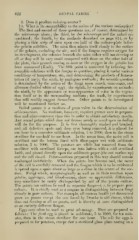Page 812 - My FlipBook
P. 812
822 DENTAL CARIES.
9. Does it produce coloring-matter?
10. AVliat is its susceptibility to the action of the various antiseptics?
The first and second of these questions are, of course, determined by
the microscope alone ; the third, by the microscope and the naked eye
combined ; the fourth, by the methods described on page 814, or by
placing a thin strip of mica upon one half of the culture-plate before
the gelatin solidifies. The mica then adapts itself closely to the surface
of the gelatin, excluding the air ; and if the fungus requires oxygen for
its development, the colonies beneath the mica either M'ill not develop at
all or they will be very small compared with those on the other half of
the plate, their growth ceasing as soon as the oxygen in the gelatin has
been consumed (Koch). The fifth point is answered by infecting fer-
mentable solutions with the fungus in question, placing it under various
conditions of temperature, etc., and determining the products of fermen-
tation (if any) ; the sixth, by analogous methods ; the seventh question
is determined by the action of the fungi upon starch, cane-sugar, and
albumen (boiled white of egg) ; the eighth, by experiments on animals
;
the ninth, by the appearance or non-appearance of color in the vegeta-
tion itself or in the surrounding medium ; the tenth, by experiments
that will readily suggest themselves. Other points to be investigated
will be mentioned farther on.
Boiled potato is a medium of great value in the determination of
schizomycetes. No medium, however, requires greater care in prepara-
tion and after-treatment than this in order to obtain satisfactory results.
Any sound potato tvhich does not become laealy or crack open on boiling
will do for the purpose. It is first thoroughly washed and brushed,
and, all defective spots and deep eyes being removed, it is placed for
one hour in a corrosive sublimate solution, 5 to 1000, then in the steam
sterilizer for one-half to one hour. In the mean time, the moist cell is
sterilized and the bottom lined with filter-paper wet with sublimate
solution, 5 to 1000. The potatoes are while hot removed from the
sterilizer with sterilized forceps, cut into halves with a cold sterilized
knife, and placed directly upon the sublimate paper (the cut surface up)
and the cell closed. Potato-sections prepared in this way should remain
unchanged indefinitely. When the potato has become cool, the cover
of the cell is carefully removed and the fungus which is to be cultivated
is spread upon a space about as large as a dime in the centre of the sec-
tion. Fungi which, morphologically as well as in their reaction upon
gelatin, agar-agar, and blood-serum, show no appreciable differences,
may sometimes be easily distinguished by aid of the potato culture.
e. to prepare pure
The potato can seldom be used to separate fungi— /.
culture. It is chiefly used as a reagent in distinguishing between fungi
already in pure culture. For example, all comma bacilli yet discovered
grow on potato excej>t the one found by Dencke in old cheese, which
does not develop at all on potato, and is thereby at once distinguished
as an entirely different fungus.
Eggs may often be used to great advantage. They are prepared as
follows : The frenli egg is placed in sublimate, 5 to 1000, for ten min-
utes, then in the steam sterilizer for one hour. The cell for eggs is
prepared as for potatoes, except that a sterilized glass plate resting on a


